人教版(2019)选择性必修 第三册Unit 5 Poems拓展课件-英语诗歌(共24张PPT)
文档属性
| 名称 | 人教版(2019)选择性必修 第三册Unit 5 Poems拓展课件-英语诗歌(共24张PPT) |
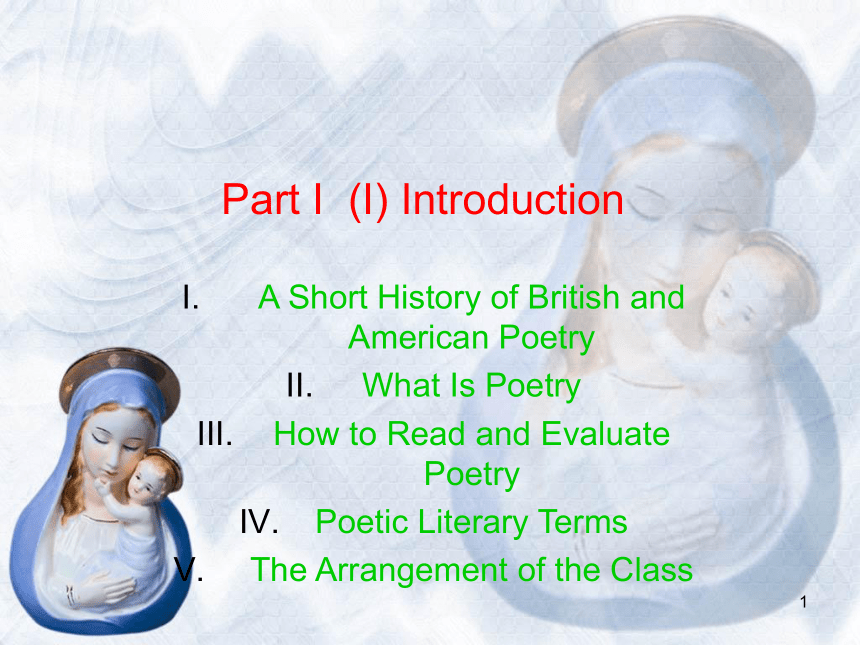
|
|
| 格式 | zip | ||
| 文件大小 | 188.5KB | ||
| 资源类型 | 教案 | ||
| 版本资源 | 人教版(2019) | ||
| 科目 | 英语 | ||
| 更新时间 | 2023-01-27 11:53:48 | ||
图片预览

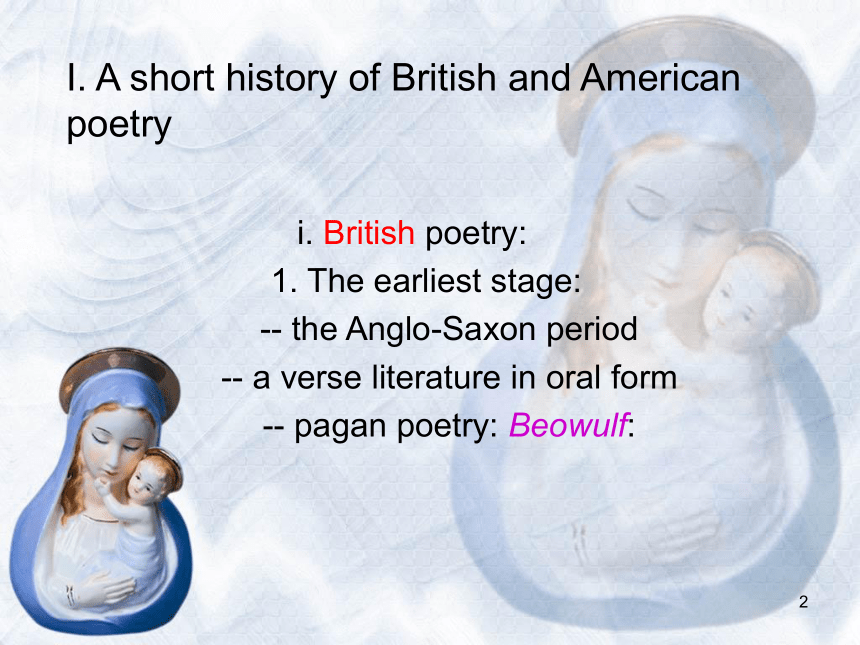
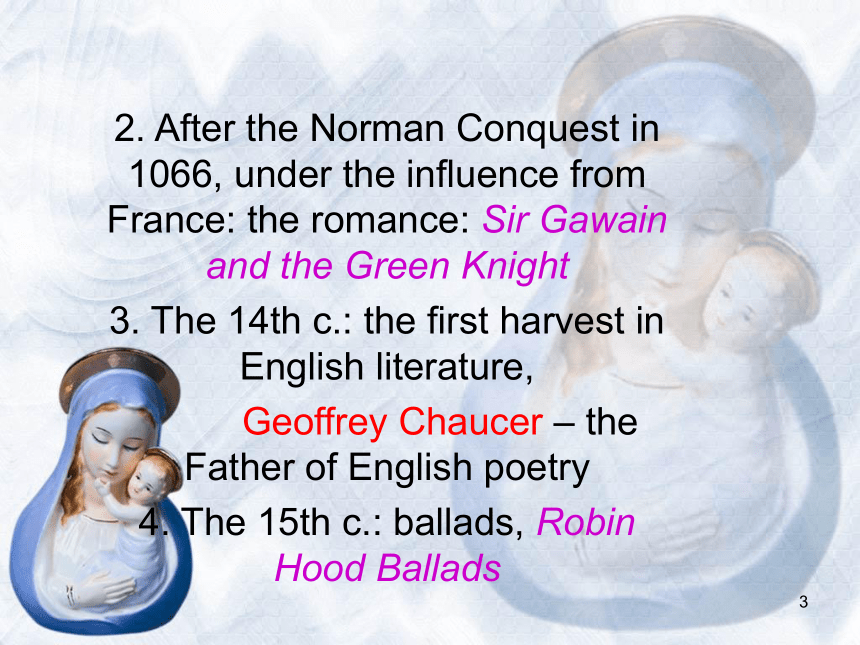
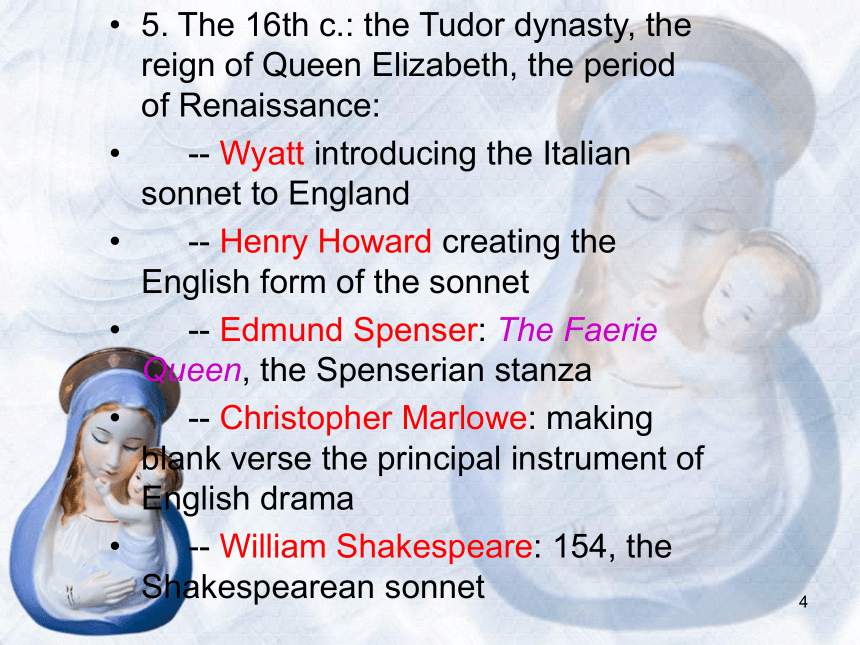
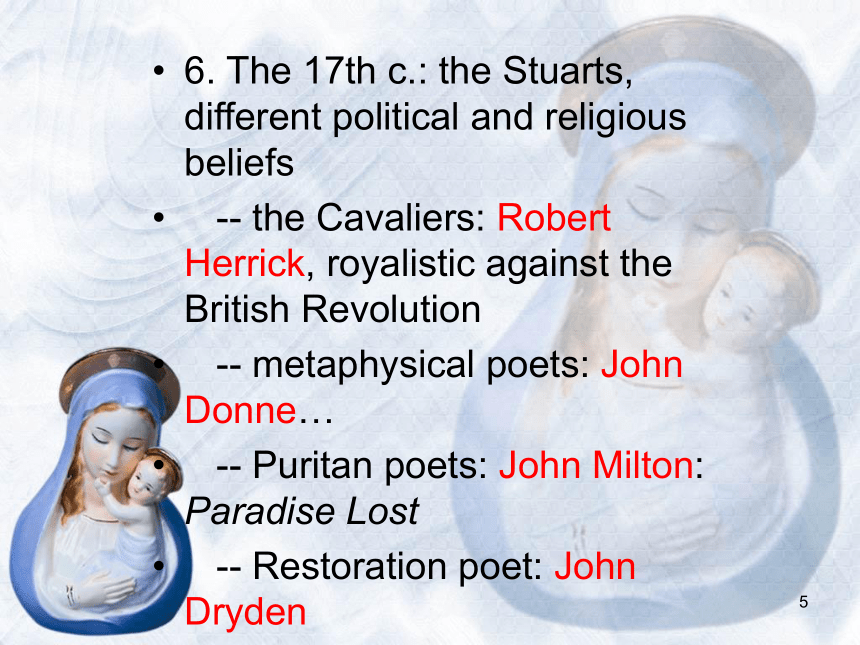
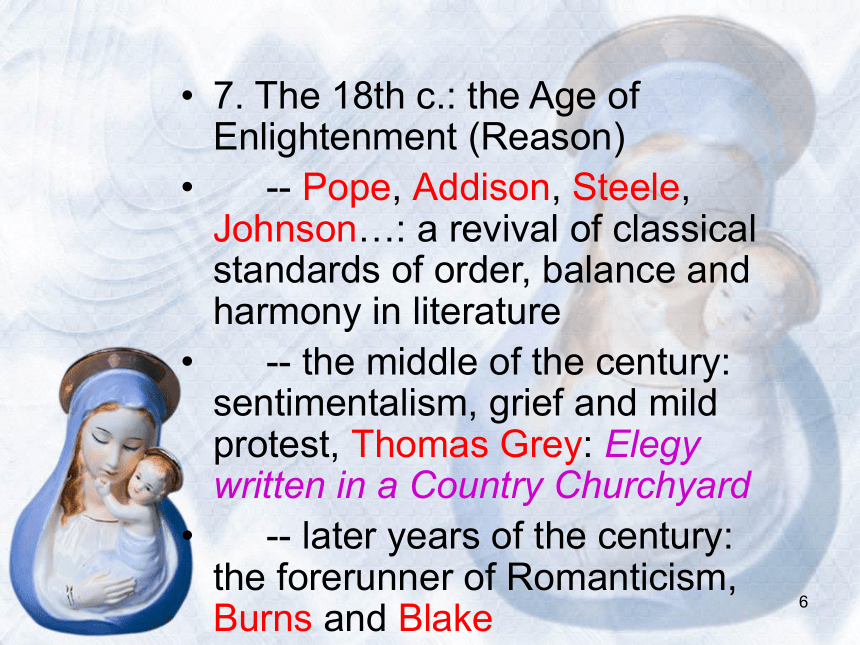
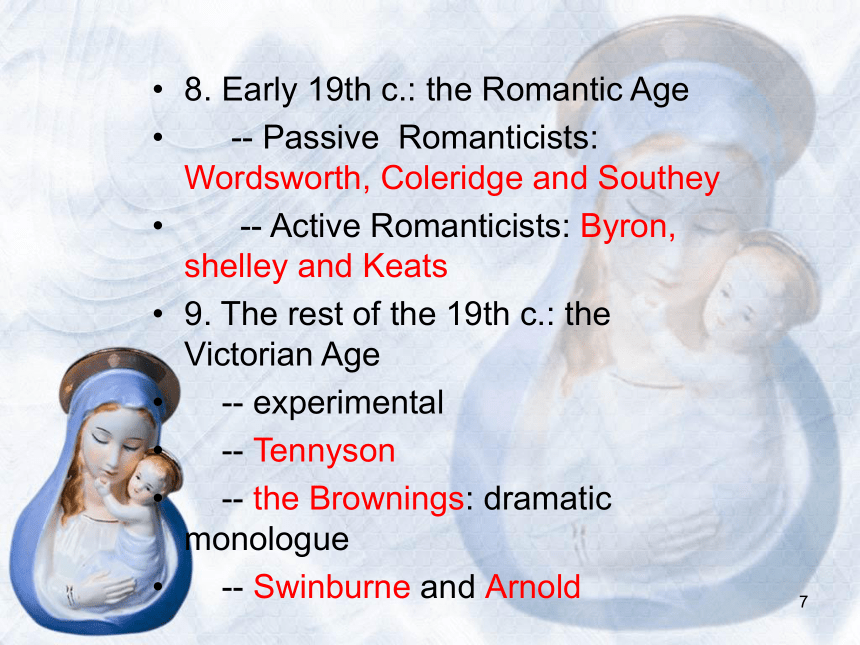
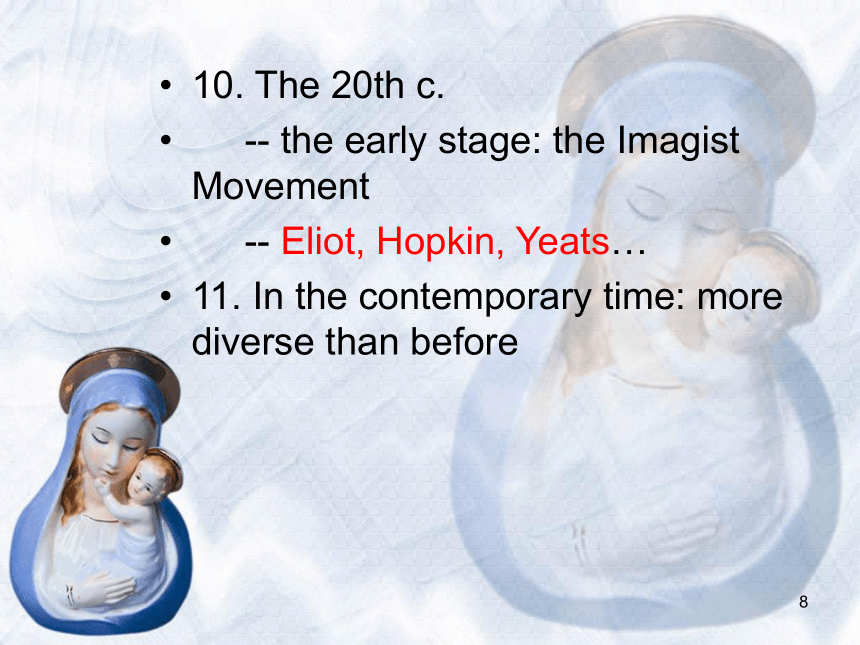
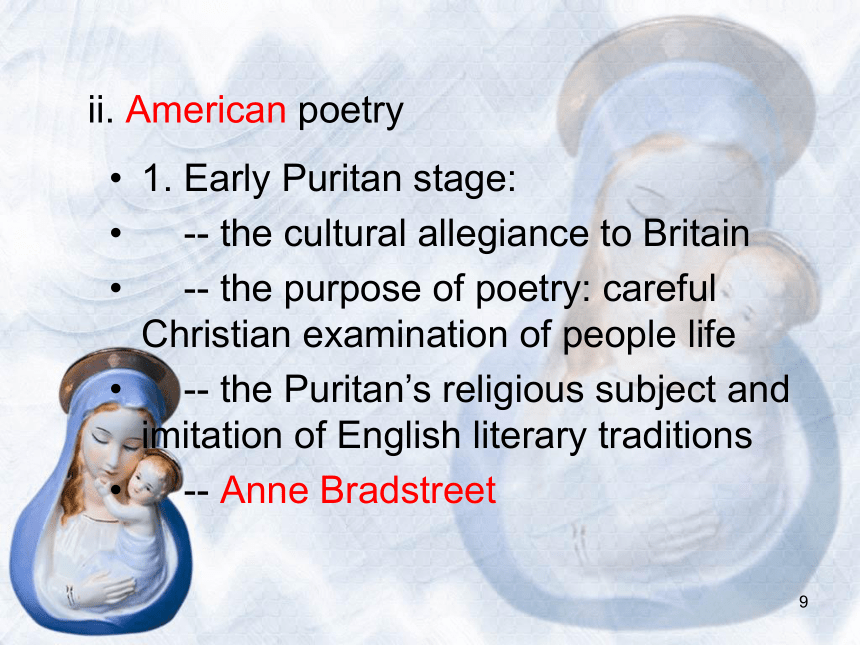
文档简介
(共24张PPT)
Part I (I) Introduction
A Short History of British and American Poetry
What Is Poetry
How to Read and Evaluate Poetry
Poetic Literary Terms
The Arrangement of the Class
I. A short history of British and American poetry
i. British poetry:
1. The earliest stage:
-- the Anglo-Saxon period
-- a verse literature in oral form
-- pagan poetry: Beowulf:
2. After the Norman Conquest in 1066, under the influence from France: the romance: Sir Gawain and the Green Knight
3. The 14th c.: the first harvest in English literature,
Geoffrey Chaucer – the Father of English poetry
4. The 15th c.: ballads, Robin Hood Ballads
5. The 16th c.: the Tudor dynasty, the reign of Queen Elizabeth, the period of Renaissance:
-- Wyatt introducing the Italian sonnet to England
-- Henry Howard creating the English form of the sonnet
-- Edmund Spenser: The Faerie Queen, the Spenserian stanza
-- Christopher Marlowe: making blank verse the principal instrument of English drama
-- William Shakespeare: 154, the Shakespearean sonnet
6. The 17th c.: the Stuarts, different political and religious beliefs
-- the Cavaliers: Robert Herrick, royalistic against the British Revolution
-- metaphysical poets: John Donne…
-- Puritan poets: John Milton: Paradise Lost
-- Restoration poet: John Dryden
7. The 18th c.: the Age of Enlightenment (Reason)
-- Pope, Addison, Steele, Johnson…: a revival of classical standards of order, balance and harmony in literature
-- the middle of the century: sentimentalism, grief and mild protest, Thomas Grey: Elegy written in a Country Churchyard
-- later years of the century: the forerunner of Romanticism, Burns and Blake
8. Early 19th c.: the Romantic Age
-- Passive Romanticists: Wordsworth, Coleridge and Southey
-- Active Romanticists: Byron, shelley and Keats
9. The rest of the 19th c.: the Victorian Age
-- experimental
-- Tennyson
-- the Brownings: dramatic monologue
-- Swinburne and Arnold
10. The 20th c.
-- the early stage: the Imagist Movement
-- Eliot, Hopkin, Yeats…
11. In the contemporary time: more diverse than before
ii. American poetry
1. Early Puritan stage:
-- the cultural allegiance to Britain
-- the purpose of poetry: careful Christian examination of people life
-- the Puritan’s religious subject and imitation of English literary traditions
-- Anne Bradstreet
2. Colonial poets of the 18th c.:
-- traditional forms with new subjects in order to create the first truly American poetry
-- Philip Freneau: The Wild Honey Suckle
-- nature
3. The 19th c.: real literary value
-- Bryant, Poe..
-- the New England Group: Longfellow, Emerson, Thoreau, transcendentalism
4. From the middle of the 19th c.:
-- Walt Whitman: bridging the gap between the New England Group and the contemporary poets, Leaves of Grass
-- Emily Dickinson: intensity of emotion and idiosyncratic form
-- Herman Melville
5. The 20th c.:
-- Robinson, Frost, Sandburg
-- the Imagist Movement: Ezra Pound, T.S. Eliot, Stein, Stevens, Williams, Cummings, Hughes, Crane
-- After WWII: the Confessional movement, the Black Mountain poets…
-- 1970s: surrealism
-- 1980s: the New Formalists
II. What is Poetry
i. Can you give a definition to poetry
ii. Let’s see some famous definitions in history:
1. Plato
2. Aristotle
3. Sidney
4. Wordsworth
5. Shelley
…
What is poetry
-- “poetry, therefore, is a more philosophical and higher thing than history, for poetry tends to express the universe, history, the particular”
-- poetry is a species of imitation or mimesis
-- using different mediums, objects and modes in order to carry out an imitation
-- Aristotle: Poetics
What is poetry
“poetry is the spontaneous overflow of powerful feelings: it takes its origin from emotion recollected in tranquility…”
-- William Wordsworth in the preface to Lyrical Ballads
iii. Difficulty in arriving at a final definition:
iv. Possibility of making an attempt to describe its properties, function, and characteristics as clearly as possible
v. But, at least, poetry uses the best language.
vi. Poem, Poetry and Verse
1. Poem 诗歌
-- piece of creative writing in verse, esp. one expressing deep feelings or noble thoughts in beautiful language, written with the intention of communicating an experience
2. Poetry诗歌(总称)
-- poems collectively or in general
3. Verse 韵文;诗歌
-- writing arranged in lines, often with a regular rhythm or rhyme scheme; poetry
III. How to read and evaluate a poem
i. A premise:
Poetry is written to read aloud and heard.
ii. Some basic steps:
1. first-time overall reading for a general impression
2. identifying the sentence structure
3. figuring out the meter
4. reading aloud for the rhyme and rhythm
5. checking new and unknown words
6. marking off any sections
7. analyzing the tone
8. re-reading
9. asking questions for literary study
iii. Literary evaluation:
1. evaluation
-- making an assessment of the poem’s literary value
-- making a judgment on how good and successful it is in the achievements of its poetic goals
2. a basic way to start
-- to paraphrase
3. Reading for the themes of a poem
1) Theme
-- an abstraction or generalization drawn from the details of literary work and refers to an idea or intellectually apprehensible meaning inherent and implicit in a work
2) Asking questions about themes
3) Warning:
-- possibility of multiple themes
-- neither to oversimplify nor to distort
-- possibility of being beyond statement
IV. Poetic Literary Terms
Learn and use them as many as possible!
V. The Arrangement of the Class
i. Time table
Week Content
1 Introduction
2 Types of poetry
3 Diction, syntax and tone
4 Sound effect: rhyme and rhythm
6 Imagery
7 Figures of speech
8 Symbolism, allegory and allusion
5,9 Two weeks kept for reservation
ii. Previewing
iii. Reviewing, discussion and presentation
Part I (I) Introduction
A Short History of British and American Poetry
What Is Poetry
How to Read and Evaluate Poetry
Poetic Literary Terms
The Arrangement of the Class
I. A short history of British and American poetry
i. British poetry:
1. The earliest stage:
-- the Anglo-Saxon period
-- a verse literature in oral form
-- pagan poetry: Beowulf:
2. After the Norman Conquest in 1066, under the influence from France: the romance: Sir Gawain and the Green Knight
3. The 14th c.: the first harvest in English literature,
Geoffrey Chaucer – the Father of English poetry
4. The 15th c.: ballads, Robin Hood Ballads
5. The 16th c.: the Tudor dynasty, the reign of Queen Elizabeth, the period of Renaissance:
-- Wyatt introducing the Italian sonnet to England
-- Henry Howard creating the English form of the sonnet
-- Edmund Spenser: The Faerie Queen, the Spenserian stanza
-- Christopher Marlowe: making blank verse the principal instrument of English drama
-- William Shakespeare: 154, the Shakespearean sonnet
6. The 17th c.: the Stuarts, different political and religious beliefs
-- the Cavaliers: Robert Herrick, royalistic against the British Revolution
-- metaphysical poets: John Donne…
-- Puritan poets: John Milton: Paradise Lost
-- Restoration poet: John Dryden
7. The 18th c.: the Age of Enlightenment (Reason)
-- Pope, Addison, Steele, Johnson…: a revival of classical standards of order, balance and harmony in literature
-- the middle of the century: sentimentalism, grief and mild protest, Thomas Grey: Elegy written in a Country Churchyard
-- later years of the century: the forerunner of Romanticism, Burns and Blake
8. Early 19th c.: the Romantic Age
-- Passive Romanticists: Wordsworth, Coleridge and Southey
-- Active Romanticists: Byron, shelley and Keats
9. The rest of the 19th c.: the Victorian Age
-- experimental
-- Tennyson
-- the Brownings: dramatic monologue
-- Swinburne and Arnold
10. The 20th c.
-- the early stage: the Imagist Movement
-- Eliot, Hopkin, Yeats…
11. In the contemporary time: more diverse than before
ii. American poetry
1. Early Puritan stage:
-- the cultural allegiance to Britain
-- the purpose of poetry: careful Christian examination of people life
-- the Puritan’s religious subject and imitation of English literary traditions
-- Anne Bradstreet
2. Colonial poets of the 18th c.:
-- traditional forms with new subjects in order to create the first truly American poetry
-- Philip Freneau: The Wild Honey Suckle
-- nature
3. The 19th c.: real literary value
-- Bryant, Poe..
-- the New England Group: Longfellow, Emerson, Thoreau, transcendentalism
4. From the middle of the 19th c.:
-- Walt Whitman: bridging the gap between the New England Group and the contemporary poets, Leaves of Grass
-- Emily Dickinson: intensity of emotion and idiosyncratic form
-- Herman Melville
5. The 20th c.:
-- Robinson, Frost, Sandburg
-- the Imagist Movement: Ezra Pound, T.S. Eliot, Stein, Stevens, Williams, Cummings, Hughes, Crane
-- After WWII: the Confessional movement, the Black Mountain poets…
-- 1970s: surrealism
-- 1980s: the New Formalists
II. What is Poetry
i. Can you give a definition to poetry
ii. Let’s see some famous definitions in history:
1. Plato
2. Aristotle
3. Sidney
4. Wordsworth
5. Shelley
…
What is poetry
-- “poetry, therefore, is a more philosophical and higher thing than history, for poetry tends to express the universe, history, the particular”
-- poetry is a species of imitation or mimesis
-- using different mediums, objects and modes in order to carry out an imitation
-- Aristotle: Poetics
What is poetry
“poetry is the spontaneous overflow of powerful feelings: it takes its origin from emotion recollected in tranquility…”
-- William Wordsworth in the preface to Lyrical Ballads
iii. Difficulty in arriving at a final definition:
iv. Possibility of making an attempt to describe its properties, function, and characteristics as clearly as possible
v. But, at least, poetry uses the best language.
vi. Poem, Poetry and Verse
1. Poem 诗歌
-- piece of creative writing in verse, esp. one expressing deep feelings or noble thoughts in beautiful language, written with the intention of communicating an experience
2. Poetry诗歌(总称)
-- poems collectively or in general
3. Verse 韵文;诗歌
-- writing arranged in lines, often with a regular rhythm or rhyme scheme; poetry
III. How to read and evaluate a poem
i. A premise:
Poetry is written to read aloud and heard.
ii. Some basic steps:
1. first-time overall reading for a general impression
2. identifying the sentence structure
3. figuring out the meter
4. reading aloud for the rhyme and rhythm
5. checking new and unknown words
6. marking off any sections
7. analyzing the tone
8. re-reading
9. asking questions for literary study
iii. Literary evaluation:
1. evaluation
-- making an assessment of the poem’s literary value
-- making a judgment on how good and successful it is in the achievements of its poetic goals
2. a basic way to start
-- to paraphrase
3. Reading for the themes of a poem
1) Theme
-- an abstraction or generalization drawn from the details of literary work and refers to an idea or intellectually apprehensible meaning inherent and implicit in a work
2) Asking questions about themes
3) Warning:
-- possibility of multiple themes
-- neither to oversimplify nor to distort
-- possibility of being beyond statement
IV. Poetic Literary Terms
Learn and use them as many as possible!
V. The Arrangement of the Class
i. Time table
Week Content
1 Introduction
2 Types of poetry
3 Diction, syntax and tone
4 Sound effect: rhyme and rhythm
6 Imagery
7 Figures of speech
8 Symbolism, allegory and allusion
5,9 Two weeks kept for reservation
ii. Previewing
iii. Reviewing, discussion and presentation
